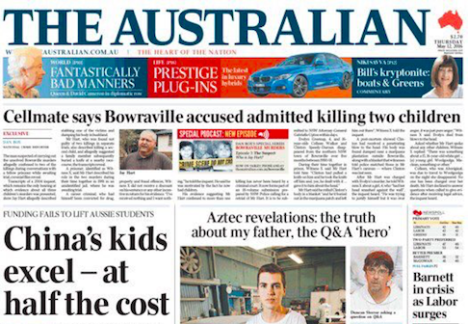ABCs: The Australian slides below 100,000 copies for the first time
News Corp’s The Australian has seen its Monday to Friday print circulation slip below the 100,000 as rival Fairfax Media masthead, The Australian Financial Review, dropped below 50,000.
According to the latest figures from the Audit Bureau of Circulations, national broadsheet The Australian had a March to June / Monday to Friday print circulation of 99,027 – a year-on-year decline of 2.50% – down from 101,615 in the same period last year.
Andrew Jaspan, editor of The Conversation and former editor of The Age, suggested that the figure is meaningless and “nobody really cares anymore” about the circulation figures.



A small correction: you state that The Canberra Times on Sunday dropped by 0.90 percent. I believe the figure is 9.9 percent (9.88…)
Thanks Daniel S, you are most right.
I’ve fixed that up.
Cheers,
Miranda – Mumbrella
I find it astonishing that Fairfax want to race to be the Digital heroes of news when the population have no brand loyalty on digital news. They certainly did have known and loved brands for the printed titles they seem to be harpooning – very odd behaviour, can’t understand why shareholders would value a company kissing goodbye to millions of dollars in this way.
Jaspan remains clueless about the business. Think of this: national newspapers are printed in many places. Printing is a manufacturing process and a scale business. It is certain now that the AFR is wasting more copies starting the press in most places than it is selling. It is possible that this is also true of the oz in some cases.
On these numbers both the oz and afr will be losing quite a lot of money. The AFR has cut back its core staff and that’s showing in the cratering sales.
The big question is: can Mr Hall outlast Mr Hambly? Game over, I suspect.
It’s not just about total print and digital readership for every advertiser. Print circulation numbers do matter, and having an accurate measure of them matters too. Canny advertisers still like print, but only if they can trust the numbers and if publishers accept that the rate will have to fall with sales. Publishers may be making a mistake if they glibly assume those advertisers will migrate all their print advertising dollars to digital if and when the printing presses are finally silenced.
There’s no evidence that newspaper web sites make enough dough to pay the staff cost. So it’s fair to assume that the bills get paid by print income. In which case what’s totally clear is that some of these titles are dead in the water.
On these numbers the AFR, weekday SMH and Australian and the Age all are simply hanging around in the hope that someone else goes first.
Publishers asking EMMA for readership numbers is like the Evil Queen asking the mirror if she’s the fairest of them all.
Miranda is smashing it today, great coverage!
Shame about the double digit slide for the Fin, I think it’s clearly the best print daily in AUS. Hope they keep Aston & Laura Tingle.
The “digital transition” strategy might be necessary for FXJ shareholders but I’ll probably stop reading entirely when they chop the print AFR
1212: is Aston the loser on the back page who goes on about his lame celebrity and on one memorable occasion referred to his erection??
Hi Critic,
Yes Aston is the “loser” on the back page. The, um, loser who won a Kennedy Award for his writing earlier this month: https://mumbrella.com.au/fairfax-journos-win-13-trophies-nsw-journalism-kennedy-awards-387922.
A few years back, News Ltd got $b for the imputed value of the masthead in some tax dodge. What goes up goes down: now its dropped, do the shareholders get to be told the value has gone?